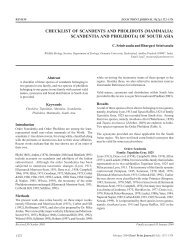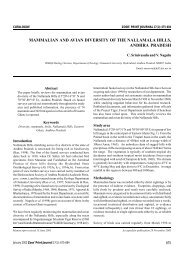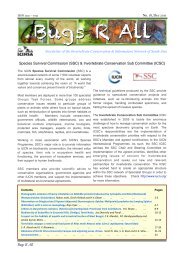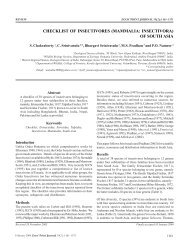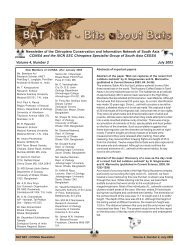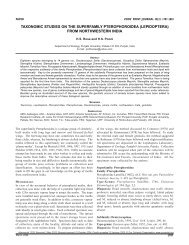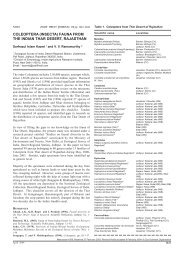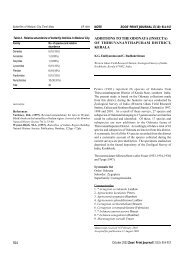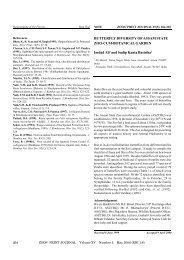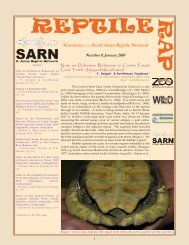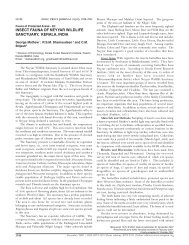Hosagoudar Meliolaceous fungi III 1494 - zoos' print
Hosagoudar Meliolaceous fungi III 1494 - zoos' print
Hosagoudar Meliolaceous fungi III 1494 - zoos' print
You also want an ePaper? Increase the reach of your titles
YUMPU automatically turns print PDFs into web optimized ePapers that Google loves.
Table 2.Contrasts between Set and System.sErsa group of football playersa corpsea group of employeesa set of planetsa group of strrdentsSYSTEMSa football teama living bodya firma solr systema classTablc 3.Contrasts between Sct ild System.SUBORDINATESIfrTElUSturc fmtball teamsa sct of bodiesa sc of firmssolrr systemsclassesSIJPEriORDINATEgrsl7gMe fuo6all gamee group of personscaporate markeplacee gilaxyarchoolFLEGl.Globe, of Crdtr:ral auilhimalArtiyities arrd Evms-@983
<strong>Meliolaceous</strong> <strong>fungi</strong> on wild edible plantsV.B. <strong>Hosagoudar</strong>Materials examined: On leaves of Rubus ellipticus Smith (Rosaceae), Kalimpong,West Bengal, March 19, 1957, J.N. Kapoor HCIO 26605; Crataegus crenulataRoxb. (Rosaceae), Chaubattia, Uttar Pradesh, 15.x.1959, J.N. Kapoor HCIO28331; Rubus calycinus Don., Manebhanjan, Darjeeling, West Bengal, May 17,1967, Coll. Unknown IMI 133535; R. vulgaris Meikle, Balehonnur, Karnataka,28.iv.1946, M.J. Thirumalachar HCIO 10900.Description: Colonies amphigenous, mostly epiphyllous, dense, crustose, upto 2mm in diameter. Hyphae mostly straight, branching mostly opposite atwide angles, loosely reticulate, cells 37-50 x 6-8µm. Appressoria alternate,antrorse to spreading, 24-28µm long; stalk cells cylindrical to cuneate, 9-12.5µm long; head cells globose, irregularly sublobate, 12-15.5 x 18-25µm.Phialides mixed with appressosria, opposite to alternate, conoid to ampulliform,18-28 x 9-12.5µm. Perithecia mostly grouped at the centre of the colony, up to300µm in diam.; perithecial appendages many, cylindrical to conoid twisted,rounded at the apex, 49-95 x 18-25µm; ascospores ellipsoidal, mostly curved,3-septate, 40-43.5 x 15-18µm.Host range: Rubus spp.Distribution: India8. Armatella litseae (P. Henn.) Theiss. & Sydow, Ann. Mycol. 13: 235, 1915;Hansf. & Thirum., Farlowia 3: 286, 1984; Kar & Maity, Norway J. Bot. 19: 250,1972; Hosag., J. Econ. Taxon. Bot. 15: 200, 1991; Yanxing, Yousheng, Bin &Guangzheng, Flora Fungorum Sinicorum 4: 48, 1996.Dimerosporium litseae P. Henn., Bot. Jahrb. Syst. 32: 42, 1903.Artallendea cinnamomi Bat. & Maia, Atas Inst. Micol. Recife 1: 222, 1960.Materials examined: On leaves of Neolitsea scrobiculata (Meisner) Gamble,Nandi Hills, Karnataka, India, M.J. Thirumalachar 901 pp.; Kerala, India,6.xii.1983, V.B. <strong>Hosagoudar</strong> MH 78117, 78190; Coimbatore, Tamil Nadu, India,17.i.1986, V.B. <strong>Hosagoudar</strong> MH 82667; on Daphnedium pulcherrima, West Bengal,India, May 9, 1967, M.K. Maity IMI 136371, PCC 1249.Description: Colonies hypophyllous, thin, crustaceous, up to 6mm in diameter,rarely confluent. Hyphae smooth walled, substraight to undulate, branchingmostly alternate at wide angles, loosely reticulate, cells 16-30 x 6-8mm.Appressoria alternate, about 5% opposite, antrorse, straight to curved, 15-20mm long; stalk cells single celled, cylindrical to cuneate, 3-6.5mm long; headcells globose, stellately sublobate, 11-13.5 x 15-16mm. Perithecia seated ontortuous exappressoriate mycelium, scattered, verrucose, up to 300mm indiam.; ascospores initially hyaline and continuous, oblong with tounded ends,dumb bell shaped, matured spores 1-septate with unequal cells, 30-36.5 x 11.5-13.5mm. During germination, one cell of the spore enlarges to produceappressorium and the other empties into it and collapses.Host range: Neolitsea zeylanica, Daphnedium pulcherrimaDistribution: Asia9. Asteridiella acronychiae-pedunculatae Hosag. in Hosag. & Goos,Mycotaxon 42: 126, 1991; Hosag., Meliolales of India, p79, 1996Materials examined: On leaves of Acronychia pedunculata (L.) Miq. (Rutaceae),Eremeparai, Top Slip, Coimbatore, Tamil Nadu, Dec. 20, 1990, V.B. <strong>Hosagoudar</strong>HCIO 30515.Host range: Acronychia pedunculataDistribution: IndiaDescription: Colonies amphigenous, dense, crustose, up to 2mm in diameter,rarely confluent. Hyphae straight to substraight, branching alternate to oppositeat acute angles, loosely reticulate, cells 27-34 x 7-9.5µm. Appressoria alternate,straight to slightly curved, antrorse to subantrorse, 27-40.5µm long; stalk cellscylindrical to cuneate, 9-18.5µm long; head cells clavate, ovate, cylindrical,entire to angular, 18-21.5 x 12-15.5µm. Phialides numerous, mixed withappressoria, alternate to opposite, ampulliform, 24-31 x 9-12.5µm. Peritheciascattered, up to 115µm in diam; perithecial cells conoid to mammiform, up to18.5µm long; ascospores obovoidal, 4-septate, constricted at the septa, 34-37.5 x 15-21.5µm.10. Asteridiella anamalaiana Hosag. in Hosag. & Goos, Mycotaxon 42: 127,1991, Hosag., Meliolales of India, p81, 1996.Materials examined: On leaves Sterculia urens of Roxb. (Sterculiaceae),Nedungundru, Valparai, Veloniae, Coimbatore, Tamil Nadu, 23.xii.1990, V.B.<strong>Hosagoudar</strong> HCIO 30529 (as Meliola anamalaiana).Description: Colonies epiphyllous scattered, dense, crustose to velvety, up to2mm in diameter. Hyphae substraight to crooked, branching opposite to irregularat acute angles, loosely to closely reticulate, cells 24-28 x 6-8µm. Appressoriaalternate, mostly antrorse, 21-28µm long; stalk cells cylindrical to cuneate, 6-9.5µm long; head cells globose, angular to rarely sublobate, 15-18 x 18-22µm.Phialides numerous, mixed with appressoria, opposite to alternate, ampulliform,18-22 x 6-9.5µm. Perithecia scattered, up to 140µm in diam.; perithecial cellsprotruded, conoid, curved at the apex, up to 15µm long; ascospores obovoidalto cylindrical, 4-septate, slightly constricted at the septa, 43-53 x 18-22µm.Host range: Sterculia urensDistribution: India11. Asteridiella caseariicola Hosag., Meliolales of India, p 81, 1996.Materials examined: On leaves of Casearia esculenta Roxb. (Flacourtiaceae),M.K. Vayal, Kanniyakumari dist., Tamil Nadu, 27.ii.1994, V.B. <strong>Hosagoudar</strong>HCIO 41628 .Description: Colonies amphigenous, mostly epiphyllous, dense, crustose, upto 1mm in diam., rarely confluent. Hyphae straight to substraight, branchingmostly opposite at acute angles, loosely to closely reticulate, cells 18-28 x 6-8µm. Appressoria alternate, antrorse, 27-43.5µm long; stalk cells cuneate, 9-18.5µm; head cells globose, stellately lobate, 18-24 x 18-25µm. Phialidesmixed with appressoria, alternate to opposite, ampulliform, 18-28 x 6-8µm.Perithecia loosely grouped, up to 250µm in diam.; peridial cells mammiform,15-25µm long; ascospores fusiform, mostly curved, 3-septate, 49-53 x 15-18.5µm.Host range: Casearia esculentaDistribution: India12. Asteridiella dilleniae Hosag. & Kamar., J. Econ. Taxon. Bot. 25, 553,2001.Materials examined: On leaves of Dillenia pentagyna (Dilleniaceae), Kerala,India, 19.xi.2000, M. Kamarudeen HCIO 43684, TBGT 353.Description: Colonies epiphyllous, dense, minute, up to 1mm in diameter,confluent. Hyphae substraight to flexuous, branching alternate to irregular atacute to wide angles, loosely to closely reticulate, cells 17-24 x 8-10mm.Appressoria alternate, antrorse to subantrorse, 20-28mm long; stalk cellscylindrical to cuneate, 6-11mm long; head cells ovate to globose, entire, 14-17x 14-16mm. Phialides borne on a separate mycelial branch, alternate, oppositeto unilateral, ampulliform, 19-24 x 8-10mm. Perithecia scattered, up to 150mmin diameter; perithecial wall cells prominent, conoid, mammiform, attenuatedand broadly rounded at the apex, straight to curved at the tip, up to 22mm long;ascospores oblong to cylindrical, 4-septate, constricted, 40-42 x 14-16mm.Host range: Dillenia pentagynaDistribution: India13. Asteridiella tremae (Speg.) Hansf., Sydowia 10: 50, 1957; Hansf., SydowiaBeih. 2: 316, 1961; Patil & Mahamulkar, Indian Phytopathol. 52: 246, 1999.Meliola tremae Speg., Ann. Mus. Nac. Buenus Aires 23: 45, 1912.Irenina tremae (Speg.) Stev., Ann. Mycol. 25: 457, 1927.Materials examined: On leaves of Trema orientalis (L.) Blume (Ulmaceae), in thecampus of Tropical Botanic Garden and Research Institute, Palode,Thiruvananthapuram, Kerala, 18.xii.2001, H. Biju HCIO 44490, TBGT 780.Description: Colonies epiphyllous, thin to subdense, up to 2mm in diameter,rarely confluent. Hyphae straight to flexuous, branching alternate, opposite toirregular at acute to wide angles, loosely reticulate, cells 30-45 x 4-6µm.Appressoria alternate, often distantly placed, antrorse, rarely recurved, 16-24µm long; stalk cells cylindrical to cuneate, 3-11µm long; head cells ovate toglobose, entire, truncate at the apex, rarely sublobate, 12-14 x 9-11µm. Phialidesmixed with appressoria, alternate to opposite, ampulliform, 15-18 x 6-8µm.Perithecia scattered, up to 150µm in diam.; perithecial wall cells conoid tomammiform, up to 14µm long; ascospores oblong, 4-septate, constricted, 35-38 x 14-16µm.Host range: Trema orientalisDistribution: Tropics14. Irenopsis benguetensis Stev. & Rold. ex Hansf., Sydowia 26: 311,1963; Hosag. & Goos, Mycotaxon 36: 242, 1989; Hosag., Meliolales of India,p. 107, 1996.Irenopsis benguetensis Stev. & Rold. Philippine J. Sci. 56: 49, 1935; Hansf.,Sydowia Beih. 20: 321, 1961.Meliola benguetensis (Stev. & Rold.) Cif., Mycopathologia 7: 87, 1954 (nonStev. & Rold., 1935).Materials examined: On leaves of Ficus asperrima Roxb. (Moraceae), CalvaryMount, Idukki, Kerala, 12.x.1982, V.B. <strong>Hosagoudar</strong> MH 73639; Idukki, Kerala,4.x.1983, V.B. <strong>Hosagoudar</strong> MH 78155; F. gibbosa Blume, Calvary Mount, Idukki,Kerala, 21.ii.1983, V.B. <strong>Hosagoudar</strong> MH 75890; Lakshmi Estate, Idukki, Kerala,Dec. 25, 1983, V.B. <strong>Hosagoudar</strong> MH 79073, 79078; 12.x.1983, V.B.<strong>Hosagoudar</strong>MH 73639; 4.x.1983, V.B. <strong>Hosagoudar</strong> MH 78155; F. hispida L.f., Idukki, Kerala,Oct. 11, 1983, V.B. <strong>Hosagoudar</strong> MH 78943; F. exasperata Vahl, near Sholayardam, Valparai, Coimbatore, Tamil Nadu, 29.xii.1990, V.B. <strong>Hosagoudar</strong> HCIO30520; F. tinctoria Forst. ssp. gibbosa (Blume) Corner var. cuspidifera (Miq.)Chitra, Nedungundru, Velonie, Valparai, Coimbatore, Tamil Nadu, 23.xii.1990,V.B. <strong>Hosagoudar</strong> HCIO 30521; F. nervosa Heyne ex Roth, Koomati, Anamalai,Coimbatore, Tamil Nadu, March 13, 1994, V.B. <strong>Hosagoudar</strong> HCIO 41576.Description: Colonies amphigenous, mostly epiphyllous, subdense to dense,up to 4mm diameter, rarely confluent. Hyphae straight to undulate, branchingalternate at aacute angles, loosely to closely reticulate, cells 24-32 x 6-10µm.Appressoria alternate, antrorse, spreading, 30-38µm long; stalk cells cylindricalto cuneate, 11-18µm long; head cells globose, angulose, irregularly sublobate,16-22 x 14-20µm. Phialides mixed with appressoria and also borne on a separate2428October 2006 Zoos' Print Journal 21(10): 2425-2438
<strong>Meliolaceous</strong> <strong>fungi</strong> on wild edible plantsV.B. <strong>Hosagoudar</strong>mycelial branch, alternate, ampulliform, 20-26 x 8-10µm. Perithecia scatteredto aggregated, verrucose, up to 144µm in diam.; perithecial setae 5-8, straight,spreading, dark-brown at base and pale brown at the apex, obtuse and mostlystraight at the tip, up to 150µm long and 8-10µm thick; ascospores ellipsoidal,4-septate, constricted, 38-44 x 16-28µm.Host range: Ficus spp.Distribution: Tropics15. Irenopsis leeae Hansf. var. indica Hosag. in Hosag. & Goos, Mycotaxon36:243, 1989; Hosag., Meliolales of India, p. 111, 1996.Materials examined: On leaves of Leea indica (Burm.f.) Merr. (Leeaceae),Kanchiar Forest, Idukki, Kerala, 17.xii.1982, V.B. <strong>Hosagoudar</strong> HCIO 40488 ;MH 75795 ; Kanchiar forest, Idukki, Kerala, 17.xii.1982, V.B. <strong>Hosagoudar</strong> MH75795; Idukki, Kerala, 23.xii.1983, V.B. <strong>Hosagoudar</strong> MH 79032; Reservoir sideof Calvary Mount, Idukki, Kerala, Dec. 24, 1983, V.B. Hosagoduar MH 79069;Lakshmi Estate, Idukki, Kerala, Dec. 25, 1983, V.B. <strong>Hosagoudar</strong> MH 79088.Description: Colonies epiphyllous, very thin, up to 3mm in diameter. Hyphaestraight to undulate, branching opposite to alternate at wide angles, looselyreticulate, cells 18-28 x 6-8µm. Appressoria scattered, alternate to unilateral,closely antrorse, 18-24µm long; stalk cells cuneate, 6-10µm long; head cellsovate, globose, entire to irregularly sublobate, 10-18 x 16-20µm. Phialidesnumerous, mixed with appressoria, alternate to opposite, ampulliform, 16-22 x8-10µm. Perithecia scattered to grouped, verrucose, up to 150µm in diam.;perithecial setae 3-8, straight to flexuous, spreading, dark at the base and palertowards theapex, tip obtuse, 84-150 x 8-10µm; ascospores obovoidal, 4-septate,constricted, 30-36 x 12-16µm.Host range: Leea indicaDistribution: India16. Irenopsis leeae Hansf. var. javensis Hansf., Reinwardtia 3: 110, 1954;Sydowia Beih. 2: 370, 1961; Hosag., Nova Hedwigia 52: 499, 1991; Hosag.,Meliolales of India, p. 112, 1996.Materials examined: On leaves of Leea indica (Burm.f.) Merr. (Leeaceae),Koomati Settlement, near Sholayar Power Station-II, Valparai, Coimbatore,Tamil Nadu, March 28, 1990, V.B. Hosagoduar HCIO 30384.Description: Colonies epiphyllous, dense, rarely amphigenous, up to 2mm indiam., confluent. Hyphae straiaght, flexuous to slightly tortuous, branchingalternate to irregular at acute angles, loosely reticulate, cells 18-25 x 6-9.5µm.Appressoria alternate, mostly unilateral, about 1% opposite, antrorse, subantrorseto rarely reflexed, 18-25µm long; stalk cells cylindrical to cuneate, 3-9.5µmlong; head cells globose, slightly and irregularly lobate, 13-15 x 12-15.5µm.Phialides numerous, mixed with appressoria, alternate to opposite, ampulliform,18-22 x 9-12.5µm. Perithecia scattered, up to 95µm in diam.; perithecial setaestraight to tortuous, often perpendicular to the host, obtuse at the tip, up to80µm long; ascospores obovoidal, slightly constricted at the septa, 4-septate,30-37 x 13-15.5µm.Host range: Leea indicaDistribution: India17. Irenopsis murrayae Hosag. & Rajkumar, J. Econ. Taxon Bot. 25; 554,2001.Materials examined: On leaves of Murraya koenigii. (Rutaceae), Kerala,8.xi.2000, Rajkumar HCIO 43685; TBGT 354.Description: Colonies amphigenous, mostly epiphyllous, dense, velvety, up to2mm in diameter, confluent. Hyphae mostly straight, rarely substraight,branching alternate to opposite at acute angles, closely to very closely reticulate,cells 9-13 x 6-8mm. Appressoria alternate, closely placed, antrorse, 16-21mmlong; stalk cells cylindrical to cuneate, 4-7mm long; head cells ovate to globose,entire, 11-15 x 12-13mm. Phialides mixed with appressoria, scattered, oppositeto alternate, ampulliform, 12-18 x 6-10mm. Perithecia scattered to looselygrouped, verrucose, up to 190mm in diameter; perithecial setae many, simple,straight, slightly wrinkled, acute, obtuse, wall smooth to suberulate at the apex,up to 75 mm long; ascospores slightly ellipsoidal, 4-septate, constricted, 35-40x 14-18mm.Host range: Murraya koenigiiDistribution: India18. Irenopsis triumfettae (Stev.) Hansf. & Deight., Mycol. Pap. 23: 14, 1948;Hansf., Reinwardtia 3: 107, 1954; Sydowia Beih. 2: 368, 1961; Hosag. & Goos,Mycotaxon 36: 244, 1989; 42: 128, 1991; Hosag., Meliolales of India, p. 118,1996.Meliola triumfettae Stev., Illinois Biol. Monogr. 2: 30, 1916; Deighton, Mycol.Pap. 9:17, 1944.Irenopsis coronata (Speg.) Stev. var. triumfettae (Stev.) Stev., Ann. Mycol. 25:435, 1927; Stev. & Rold., Philippine J. Sci. 56: 51, 1933.Meliola coronata Speg. var. triumfettae (Stev.) Cif., Mycopathologia 8:117,1954.Irenopsis molleriana sensu Kapoor, Indian Phytopathol. 20: 151, 1967.October 2006 Zoos' Print Journal 21(10): 2425-2438Materials examined: On leaves of Triumfetta bartramia L. (Tiliaceae), Sribadam,Sikkim, 7.iv.1962, J.N.Kapoor HCIO 18362; T. pilosa Roth, Lakshmi Estate,Idukki, Kerala, 14.xii.1982, V.B.<strong>Hosagoudar</strong> MH 75746; Calvary Mount, Idukki,Kerala, 15.xii.1982, V.B.<strong>Hosagoudar</strong> MH 75779; 28.xii.1983, V.B. <strong>Hosagoudar</strong>MH 80322; Lakshmi Estate, Idukki, Kerala, 6.x.1983, V.B.<strong>Hosagoudar</strong> MH78175, 78176; T. rhomboidea Jacq., Pamba, Kerala, 10.x.1983, V.B.<strong>Hosagoudar</strong>MH 78933; near Sholayar dam, Valparai, Coimbatore, Tamil Nadu, 25.xii.1990,V.B. <strong>Hosagoudar</strong> HCIO 30524, 30525.Description: Colonies amphigenous, mostly epiphyllous, subdense, scattered,up to 3mm in diameter, rarely confluent. Hyphae undulate to tortuous, branchingopposite to alternate at wide angles, loosely to closely reticulate, cells 15-20 x6-8µm. Appressoria alternate, mostly straight, antrorse, 18-22µm long; stalkcells cylindrical to cuneate, 6-8µm long; head cells globose, entire to sublobate,12-16 x 12-14µm. Phialides mixed with appressoria, alternate to opposite,ampulliform, 18-20 x 6-8µm. Perithecia scattered to aggregated, up to 207µmin diam.; perithecial setae 6-8, straight, spreading, continuous, curved or uncinateat the apex, apex obtuse, 99-144 x 6-8µm; ascospores ellipsoidal,4-septate,constricted, 36-44 x 12-16µm.Host range: Triumfetta spp.Distribution: Tropics19. Irenopsis triumfettae Stev. var. indica Hosag. & Abraham, J. Mycopathol.Res. 36: 98, 1998.Materials examined: On leaves of Triumfetta sp (Tiliaceae), Kerala, India,8.iii.1996, V.B. <strong>Hosagoudar</strong> HCIO 44293, TBGT 81.Description: Colonies amphigenous, dense, up to 1mm in diameter, confluent.Hyphae straight to flexuous, branching irregular at acute angles, looselyreticulate, cells 24-29 x 7-9µm. Appressoria alternate, antrorse to subantrorse,17-22µm long; stalk cells cylindrical to cuneate 4-8µm long; head cells globoseto slightly ovate, entire, 12-15 x 12-15µm. Phialides numerous mixed withappressoria, alternate to opposite, ampulliform, 14-22 x 7-9µm. Peritheciascattered, globose, verrucose, up to 160µm in diameter; Perithecial setae 6-8,simple, straight to slightly curved, tortuous to beaded and granulose towardsthe apex, obtuse at the apex, up to 140µm long, ascospores oblong, 4-septate,slightly constricted at the septa, 36-46 x 12-17µm.Host range: Triumfetta sp.Distribution: India20. Meliola abrahamii Hosag., C.K. Biju & Rajkumar, Zoos’ Print J. 16: 595,2001.Materials examined: On leaves of Semecarpus anacardium L.f. (Anacardiaceae),Kerala, India, 26.x.2000, G. Rajkumar HCIO 43794, TBGT 394.Description: Colonies epiphyllous, dense up to 3mm in diameter, confluent.Hyphae straight to slightly flexuous, branching mostly opposite at acute angles,loosely to closely reticulate, cells 24-32 x 8-10µm. Appressoria alternate,antrorse to subantrorse, 28-40 µm long; stalk cells cylindrical to cuneate, 6-16µm long; head cells oblong, straight to curved, entire, angular to sublobate,22-24 x 11-16µm. Phialides mixed with appressoria, alternate to opposite,ampulliform, 19-24 x 6-8µm. Mycelial setae scattered to grouped aroundperithecia, simple straight; setae around perithecia are few, acute obtuse, up to300µm long; setae on mycelia are acute, up to 1200µm long. Perithecia scattered,up to 175µm in diameter; ascospores cylindrical, 4-septate, constricted, 46-50x 18-20µm.Host range: Semecarpus anacardiumDistribution: India21. Meliola adenanthericola Hosag., Kamarudeen & Babu in Hosag., C.K.Biju & Abraham, J. Econ. Taxon. Bot. 25: 68, 2001.Materials examined: On leaves of Adenanthera pavonia L. (Mimosaceae),Kerala, India, M. Kamarudeen & K.P. Babu HCIO 43799, TBGT 359.Description: Colonies amphigenous, mostly epiphyllous, dense up to 2mm indiameter, confluent. Hyphae mostly crooked, rarely flexuous, branchingalternate to opposite at acute to wide angles, loosely to closely reticulate, cells18-25 x 6-8µm. Appressoria alternate, antrorse to spreading, 12-21µm long;stalk cells cylindrical to cuneate, 3-10µm long; head cells predominantly globose,often oblong to cylindrical, straight to curved, entire, 9-11 x 8-10µm. Phialidesmixed with appressoria, alternate to opposite, ampulliform, 19-24 x 8-10µm.Mycelial setae scattered to grouped around perithecia, simple, straight, acuteto obtuse at the tip, up to 345µm long. Perithecia scattered, up to 125µm indiameter; ascospores cylindrical to slightly fusiform, 4-septate, constricted,35-39 x 12-15µm.Host range: Semecarpus anacardiumDistribution: India22. Meliola aequatoriensis Petrak, Sydowia 2: 339, 1948; Hansf., SydowiaBeih. 2: 613, 1961; Hosag., Nova Hedwigia 52: 500, 1991; Hosag., Meliolalesof India, p. 121, 1996.Materials examined: On leaves of Viburnum punctatum Buch.-Ham. ex D. Don2429
<strong>Meliolaceous</strong> <strong>fungi</strong> on wild edible plantsV.B. <strong>Hosagoudar</strong>53. Meliola malacotricha Speg. var. major Beeli, Bull. Jard. Bot. Etat. 7: 89,1920; Hansf., Sydowia Beih. 2: 649, 1961; Hosag. & Goos, Mycotaxon 37: 240,1990; 42: 137, 1991; Hosag., Crypt. Bot. 2/3: 186, 1991; Hosag., Raghu &Pillai, Nova Hedwigia 58: 540, 1994; Hosag., Meliolales of India, p. 249, 1996.Materials examined: On leaves of Merremia umbellate (L.) Hall.f.(Convolvulaceae), Idukki, Kerala, 3.x.1983, V.B. <strong>Hosagoudar</strong> MH 78125; Argyeriahookeri Clarke (Convolvulaceae), Vazhathope, Idukki, Kerala, 7.i.1982, V.B.<strong>Hosagoudar</strong> HCIO 40545, MH 71582; A. elliptica Choisy, Benne Forest, Nilgiris,Tamil Nadu, 24.i.1990, V.B. <strong>Hosagoudar</strong> HCIO 32827; A. setosa (Roxb.) Choisy,Topslip, Coimbatore, Tamil Nadu, 20.xii.1990, V.B. <strong>Hosagoudar</strong> HCIO 30553;Merremia umbellata (L.) Hall. (Convolvulaceae), Gersoppa, uttara Kannada,Karnataka, 24.ix.1992, P.A. Raghu HCIO 40762.Description: Colonies epiphyllous, dense, crustaceous, scattered, up to 2mmin diameter. Hyphae straight to slightly undulate, branching opposite at acuteangles, loosely to closely reticulate, cells 14-26 x 6-8µm. Appressoria opposite,about 5% unilateral, subantrorse to antrorse, spreading, 10-15µm long; stalkcells cylindrical to cuneate, 2-6µm long; head cells globose, entire, rarelybluntly pointed towards the apex, 8-10µm. Phialides mixed with appressoria,opposite and alternate, ampulliform, 14-16 x 6-8µm. Mycelial setae scatteredto grouped around perithecia, simple, straight to curved, acute at the tip, up to333µm long. Perithecia scattered to grouped, verrucose, up to 150µm in diam.;ascospores ellipsoidal, 4-septate, slightly constricted, 38-40 x 12-16µm.Host range: Merremia umbellate, Argyeria spp.Distribution: Tropics54. Meliola mangiferae Earle, Bull. New York Bot. Gard. 3: 307, 1905; Hansford,Sydowia Beih. 2: 464, 1961; Hansf. & Thirum., Farlowia 3: 296, 1948; Hansf.,Sydowia Beih. 2: 464, 1961; Hosag. & Goos, Mycotaxon 37: 240, 1990; Hosag.,Crypt. Bot. 2/3: 186, 1991; Hosag. & Ansari, J. Andaman Sci. Assoc. 7: 89,1991; Hosag., Meliolales of India, p. 250, 1996.Materials examined: On leaves of Mangifera indica L. (Anacardiaceae),Puliyannur, Kerala, 8.x.1907, E.J. Butler HCIO 1050; North Kanara, Karnataka,June 1913, G.S. Kulkarni HCIO 3316; Panamkutty, Idukki, Kerala, 15.x.1982,V.B. <strong>Hosagoudar</strong> HCIO 40546, MH 73677; 18.xii.1982, V.B. <strong>Hosagoudar</strong> MH75814; Vazhathope, Idukki, Kerala, 26.ii.1983, V.B. <strong>Hosagoudar</strong> MH 75036;Lakshmi Estate, Idukki, Kerala, 8.x.1983, V.B.<strong>Hosagoudar</strong> MH 78184; BenneForest, Nilgiris, Tamil Nadu, 24.i.1990, V.B. <strong>Hosagoudar</strong> HCIO 32823; M.andamanica King, Shoalbay, South Andaman, 23.iii.1991, A.A. Ansari HCIO.Description: Colonies hypophyllous, thin, velvety, up to 4mm in diameter.Hyphae substraight to crooked, branching opposite to irregular at wide angles,loosely reticulate, cells 27-40 x 5-6.5µm. Appressoria alternate, mostly unilateraland variously curved, 24-31µm long; stalk cells cylindrical to cuneate, 3-6.5µmlong; head cells ovate, versiform, attenuated and rounded at the apex, entire,predominantly curved, 21-25 x 9-12.5µm. Phialides mixed with appressoria,alternate to opposite, elongated, 21-28 x 8-9.5µm. Mycelial setae scattered,simple, straight, acute, obtuse to 2-3 dentate at the tip, up to 860µm long;Perithecia scattered, verrucose, up to 175µm, surface cells conoid and projecting;ascospores obovoidal to ellipsoidal, middle cell slightly larger, 49-56 x 18-22µm.Host range: Mangifera indicaDistribution: Tropics55. Meliola memecyli Sydow & Sydow, Ann. Mycol. 12: 198, 1914; Hansf. &Thirum., Farlowia 3: 297, 1948; Hansf., Reinwardtia 3: 92, 1953; Sydowia Beih.2: 155, 1961; Sreenivasulu, Nova Hedwigia Beih. 47: 431, 1974; Hosag. &Goos, Mycotaxon 37: 240, 1990; Hosag., Meliolales of India, p. 256, 1996.Materials examined: On leaves of Memecylon depressum Benth. ex Triana(Melastomataceae), Idukki, Kerala, 18.ii.1983, V.B. <strong>Hosagoudar</strong> HCIO 40547,MH 75833, 75834, 75863; Meenmutty, Idukki, Kerala, 22.xii.1983, V.B.<strong>Hosagoudar</strong> MH 78984; M. umbellatum Burm.f., Mahabaleshwar, Satara,Maharashtra, 1.ii.1984, C.R. Patil HCIO 40013; Suriyanpettai, Cuddalore, TamilNadu, 15.vii.1993, K. Ravikumar HCIO 41617; M. edule Roxb. Kakachi,Tirunelveli, Tamil Nadu, 25.ii.1994, V.B. <strong>Hosagoudar</strong> HCIO 41538.Description: Colonies amphigenous, subdense, velvety, up to 5mm in diamter,confluent. Hyphae substraight to flexuous, branching opposite to irregular atwide angles, closely reticulate, cells 22-24 x 6-8µm. Appressoria alternate,about 5% opposite, straight to variously curved, subantrorse to spreading, 18-30µm long; stalk cells cylindrical to cuneate, 4-10µm long; head cells ovate,cylindrical to conoid, entire, 16-18 x 8-10µm. Phialides mixed with appressoria,opposite to alternate, ampulliform, 20-30 x 8-10µm. Mycelial setae few,scattered, simple, acute to variously dentate at the tip, up to 1080µm long.Perithecia scattered, verrucose, up to 204µm in diam.; ascospores obovoidal,4-septate, constricted, 40-54 x 17-24µm.Host range: Memecylon spp.Distribution: Asia56. Meliola mucunae-acuminatae Hansf. var. indica Hosag., Siddappa &Udaiyan, Nova Hedwigia 56: 198, 1993; Hosag., Meliolales of India, p. 261,1996.Materials examined: On leaves of Mucuna pruriens (L.) DC. (Fabaceae),Anmode, Maharashtra, 10.x.1994, A.N. Thite HCIO 31907.Description: Colonies epiphyllous, thin to dense, confluent. Hyphae crooked,branching opposite to irregular at wide angles, loosely reticulate, cells 15-28 x4-6.5µm. Appressoria alternate, about 5% opposite, straight to variously curved,12-18.5µm long; stalk cells cylindrical to cuneate, 3-6.5µm long; head cellsovate, globose, entire, curved, 9-12.5 x 10-12.5µm. Phialides mixed withappressoria, alternate to opposite, conoid to ampulliform, 18.5-25 x 6-8µm.Mycelial setae few, grouped around perithecia, simple, straight, acute, obtuseto few dentate at the tip, up to 280µm long. Perithecia scattered, up to 125µmin diam.; ascospores cylindrical, 4-septate, constricted at the septa, 30-34 x12-15.5µm.Host range: Mucuna pruriensDistribution: India57. Meliola nothopegiae Hansf., Sydowia 10: 80, 1957; Sydowia Beih. 2: 469,1961; Thite & Kulkarni, J. Shivaji Univ. 6: 163, 1973; Hosag., Lakshmanan &Viswanathan, Indian J. Bot. 11: 187, 1988; Hosaag. & Goos, Mycotaxon 37:242, 1990; Hosag., Kaveriappa, Raghu & Goos, Mycotaxon 51: 113, 1994;Hosag., Meliolales of India, p. 266, 1996.Materials examined: On leaves of Nothopegia colebrookiana (Wight) Bl.(Anacardiaceae), Taleguppa, Karnataka, 29.x.1911, G.S. Kulkarni HCIO 1993;N. beddomei Gamble, Kanchiar forest, Idukki, Kerala, 12.xii.1982, V.B.<strong>Hosagoudar</strong> MH 75765; 29.xii.1983, V.B. <strong>Hosagoudar</strong> MH 80339; N. heyneana(Hook.f.) Gamble, near Kariar Dam, Tamil Nadu; 11.xii.1986, A. Rajendran AMH7138; N. racemosa (Dalz.) Ramam., Gersoppa, Uttara Kannada, Karnataka,21.x.1992, P.A. Raghu HCIO 40874.Description: Colonies amphigenous, mostly epiphyllous, subdense, up to 5mmin diameter. Hyphae of the epiphyllous colonies straight, branching regularlyopposite at acute angles, loosely reticulate. While the hyphae of thehypophyllous colonies crooked, branching opposite to irregular at wide angles,cells 18-26 x 6-8µm. Appressoria alternate, subantrorse to antrorse, 24-36µmlong; stalk cells cuneate, 6-14µm long; head cells cylindrical, versiform, slightlyangulose, entire, 16-22 x 12-14µm. Phialides mixed with appressoria, alternateto opposite, ampulliform, 10-20 x 8-10µm. Mycelial setae scattered to groupedaround perithecia, straight, simple, acute at the tip, up to 675µm long. Peritheciascattered to aggregated, verrucose, up to 164µm in diam.; ascospores obovoidal,4-septate, constricted, 44-50 x 18-20µm.Host range: Nothopegia spp.Distribution: India58. Meliola ochrocarpi Thite & Patil, Geophytology 13: 125, 198; Hosag.,Meliolales of India, p. 266, 1996.Materials examined: On leaves of Mammia suriga (Buch.-Ham. ex Roxb.)Kosterm. (Ochrocarpus longifolius (Wight) Benth. ex T. And.) (Clusiaceae),Amboli, Radhanagari, Maharashtra, Oct. 1980, A.N. Thite HCIO 33671.Description: Colonies amphigenous, dense, up to 5mm in diameter, confluent.Hyphae straight to substraight, branching mostly opposite at acute to wideangles, loosely to closely reticulate, cells 21-25 x 8-10µm. Appressoria alternate,antrorse, straight to curved, 18-22µm long; stalk cells cylindrical to cuneate, 3-6.5µm long; head cells ovate, globose, rarely hamate, entire to rarely angular,15-16 x 12-14µm. Phialides mixed with appressoria, scattered, ampulliform,21-28 x 9-10µm. Mycelial setae numerous, simple, straight to rarely curved,acute at the tip, up to 860µm long. Perithecia scattered, up to 220µm in diam.;ascospores obovoidal to cyl9indrical, 4-septate, constricted at the septa, 46-53x 18-22µm.Host range: Mammia surigaDistribution: India59. Meliola olacicola Hosag., Meliolales of India, p. 267, 1996.Materials examined: On leaves of Olax wightiana Wall. ex Wight & Arn.(Olacaceae), Amboli, Maharashtra, 12.i.1978, M.S. Patil HCIO 32563.Description: Colonies amphigenous, dense, up to 2mm in diameter, confluent.Hyphae straight, branching mostly opposite at acute to wide angles, loosely toclosely reticulate, cells 18-22 x 6-7µm. Appressoria alternate, 15% opposite,straight, subantrorse, 14-16µm long; stalk cells cylindrical to cuneate, 3-5µmlong; head cells oblong, clavate to cylindrical, entire, 12-14 x 6-9.5µm. Phialidesmixed with appressoria, alternate to opposite, conoid to ampulliform, neckstraight to curved, 15-18.5 x 6-8µm. Mycelial setae mostly grouped aroundperithecia, simple, straight, acute at the apex, up to 350µm long. Peritheciascattered, up to 180µm in diam.; ascospores oblong to cylindrical, 4-septate,strongly constricted at the septa, 45-48 x 18-20µm.Host range: Olax wightianaDistribution: India2434October 2006 Zoos' Print Journal 21(10): 2425-2438
<strong>Meliolaceous</strong> <strong>fungi</strong> on wild edible plantsV.B. <strong>Hosagoudar</strong>60. Meliola oleacearum Hosag., Sydowia 54: 55, 2002.Materials examined: On leaves of Olea dioica (Oleaceae), Kerala, India, 25.i.1997,V.B. <strong>Hosagoudar</strong>, HCIO 44122; TBGT 556.Description: Colonies hypophyllous, dense, scattered, up to 10mm in diameter,confluent. Hyphae flexuous to crooked, branching opposite to irregular atacute angles, loosely to closely reticulate, cells 20-26 x 4-6.5µm. Appressoriaalternate, antrorse, retrorse, spreading, curved towards hyphae, 14-24µm long;stalk cells cylindrical to cuneate, 3-6.5µm long; head cells ovate, oblong,narrowly oblong, cylindrical, entire, rarely angular to sublobate, straight, curvedto uncinate, 11-18 x 6-10µm. Phialides many, mixed with appressoria, alternate,ampulliform, neck elongated, 20-26 x 4-6.5µm. Mycelial setae numerous,scattered, simple, straight, flexuous, sigmoid, curved, uncinate, up to 400µmlong, subobtuse to obtuse at the tip. Perithecia scattered, up to 120µm indiameter; ascospores oblong to slightly ellipsoidal, 4-sepatet, constricted, 35-40 x 14-16µm.Host range: Olea dioicaDistribution: India61. Meliola palmicola Wint. var. africana Hansf., Sydowia 10: 81, 1957;Sydowia Beih. 2: 726, 1961; Hosag., Meliolales of India, p. 275, 1996.Materials examined: On leaves of Phoenix sp. (Arecaceae), Mudigere, Karnataka,7.ix.1903, E.J. Butler HCIO 1045; Bilkere, Karnataka, Sept. 19, 1903, E.J.Butler HCIO 3941; P. sylvestris Roxb., Burdwan, West Bengal, 12.vii.1902,Bhattacharyya HCIO 1047; Calcutta, West Bengal, S.N. Bal HCIO 3340;Hunsur, Karnataka, 20.ix.1903, E.J. Butler HCIO 1048; Talaguppa, Karnataka,Oct. 29, 1911, G.S. Kulkarni HCIO 3343; Velvae, Karnataka, 24.ix.1903, E.J.Butler HCIO 1049; Godavari, Andhra Pradesh, 16.iii.1917, P.V. SomayajuluHCIO 10401; Jorhat, Assam, 19.v.1943, S. Chowdhuri HCIO 1047; Hurali,Karnataka, 18.ii.1944, M.J. Thirumalachar HCIO 10394.Description: Colonies amphigenous, mostly epiphyllous, dense, velvety, up to7mm in diameter. Hyphae straight to undulate, branching mostly opposite atacute to wide angles, loosely reticulate, cells 16-28 x 6-8µm. Appressoriaalternate subantrorse, mostly straight, 20-28µm long; stalk cells cylindrical tocuneate, 10-14µm long; head cells subglobose, ovate, angulose to sublobate,14-18 x 12-16µm. Phialides mixed with appressoria, alternate to opposite,ampulliform, 18-24 x 6-10µm. Mycelial setae numerous, simple, straight,dentate, up to 550µm. Perithecia loosely grouped, verrucose, up to 220µm indiam.; ascospores subellipsoidal, 4-septate, slightly constricted, 50-56 x 18-22µm.Host range: Phoenix spp.Distribution: Tropics62. Meliola plectroniae Hansf., Sydowia 9: 72, 1955; Beih. 2: 702, 1961;Hosag., Meliolales of India, p. 284, 1996.Meliola coilicosa Nair & Kaul, Sydowia 36: 204, 1983; Hosag. & Goos, Mycotaxon37: 228, 1990.Materials examined: On leaves of Canthium dicoccum (Gaertn.) Teys & Benn.(Plectronia umbellate Benth. & Hook.) (Rubiaceae), Matheron, Maharashtra,16.x.1911, S.L. Ajrekar HCIO 3196 ; Mahabaleshwar, Satara, Maharashtra, Jan.1978, V.P. Kaul HCIO 33807 (type of M. coilicosa); Idukki, Kerala, 18.ii.1983,V.B. <strong>Hosagoudar</strong> HCIO 40513; C. rheedii DC., Mahabaleshwar, Satara,Maharashtra, 17.i.1985, C.R. Patil HCIO 40007.Description: Colonies hypophyllous, thin, up to 5mm in diameter, confluent.Hyphae substraight to flexuous, branching mostly alternate, branches of themain hyphae tortuous, loosely reticulate, cells 18-30 x 6-8µm. Appressoriaalternate, straight to variously curved, 24-34µm long; stalk cells aseptate tomany septate, tortuous, aseptate stalk cells 8-16µm long, while, septate stalkcells up to 80µm long; head cells semilunar, versiform, ovate, angular, straightto mostly curved, 16-22 x 10-14µm. Phialides mixed with appressoria, oppositeto alternate, ampulliform, 20-24 x 8-10µm. Mycelial setae thinly scattered,simple, straight, acute, up to 360µm long. Perithecia scattered, verrucose, upto 110µm in diam.; ascospores cylindrical, ellipsoidal, 4-septate, constricted,52-56 x 16-18µm.Host range: Canthium spp.Distribution: Tropics63. Meliola polygoni Srinivasulu, Nova Hedwigia Beih. 47: 432, 1974; Hosag.,Meliolales of India, p. 286, 1996.Type: On leaves of Polygonum chinense L. (Polygonaceae), Castle rock,Maharashtra, India, Nov. 1966, B.V. Srinivasulu MUH 144.Materials examined: Material was not available for the study.Description: Colonies epiphyllous, dense, crustose, up to 2mm in diameter.Hyphae closely reticulate, cells 20-25 x 5-7µm. Appressoria alternate, antrorseto spreading, 15-19µm long; stalk cells cylindrical to cuneate, 3-5.5µm long;head cells globose to ovate, entire, 8-13.5 x 7-11.5µm. Phialides mixed withappressoria, alternate to opposite, ampulliform, 19-23 x 4-7.5µm. Mycelialsetae numerous, scattered, simple, straight, acute at the tip, up to 250µm long.Perithecia scattered, verrucose, up to 120µm in diam.; ascospores oblong, 4-septate, slightly constricted at the septa, 32-36 x 10-12µm.Host range: Polygonum chinenseDistribution: India64. Meliola polygonicola Hosag., Meliolales of India, p. 286, 1996.Materials examined: On leaves of Polygonum chinense L. (Polygonaceae),Ambe Ghats, Maharashtra, Dec. 1972, A.N. Thite HCIO 31909.Description: Colonies epiphyllous, dense, up to 2mm in diameter, confluent.Hyphae straight to substraight, branching opposite at acute angles, very closelyreticulate and form almost solid mycelial mat, cells 12-15.5 x 5-7µm. Appressoriaopposite, very few solitary, crowded, antrorse, 12-15.5µm long; stalk cellscuneate, 3-6.5µm long; head cells globose to slightly ovate, entire, 9-12 x 8-11µm. Phialides few, mixed with appressoria, scattered to opposite, ampulliform,15-18.5 x 7-9.5µm. Mycelial setae few, simple, straight, obtuse to acute, up to400µm long. Perithecia scattered, up to 124µm in diam.; ascospores oblong tocylindrical, 4-septate, constricted at the septa, 37-41 x 15-17µm.Host range: Polygonum chinenseDistribution: India65. Meliola pongamiae Hosag. & Abraham, Nova Hedwigia 68: 483, 1998.Materials examined: On leaves of Pongamia pinnata (L.) Pierrie (Fabaceae),TBGRI campus, Thiruvananthapuram, Kerala, India, 21.i.1997, V.B. <strong>Hosagoudar</strong>TBGT 123, HCIO 42482; 20.xi.2000, V.B. <strong>Hosagoudar</strong> HCIO 42482, TBGT 123;18.xii.2000, H. Biju HCIO 44542, TBGT 828; 23.i.2001, H. Biju HCIO 44563,TBGT 850; 20.xi.2000, V.B. <strong>Hosagoudar</strong> HCIO 43950, TBGT 422; Peringammala,Thiruvanan-thapuram, Kerala, 25.xi.2000, M. Kamarudeen HCIO 43965,TBGT443.Description: Colonies epiphyllous, crustose, up to 5mm in diameter. Surroundedby yellow haloes, with yellow discolouration of the lower leaf surface, severalsuch spots causing defoliation. Hyphae straight to substraight, branching mostlyopposite at wide angles, loosely to closely reticulate, cells 17-29 x 4-8µm.Appressoria alternate, about 2% opposite, antrorse, subantrorse to retrorse, 14-22µm long; stalk cells cylindrical to cuneate, 2-7µm long; head cells ovate,globose, 12-15 x 9-12µm. Phialides mixed with appressoria, alternate to opposite,ampulliform, neck twisted, 19-22 x 7-10µm. Mycelial setae scattered, simple,straight, acute at the tip, up to 255µm long. Perithecia scattered loosely togrouped, verrucose, up to 150µm in diameter; ascospores oblong to cylindrical,4-septate, slightly constricted, 38-44 x 14-17µm.Host range: Pongamia pinnataDistribution: India66. Meliola premnicola Hosag. in Hosag. & Goos, Mycotaxon 37: 243, 1990;Hosag., Meliolales of India, p. 288, 1996.Materials examined: On leaves of Premna glaberrima Wight (Verbenaceae),Idukki, Kerala, 18.ii.1983, V.B. <strong>Hosagoudar</strong> HCIO 40554, MH 75837.Description: Colonies epiphyllous, subdense, up to 5mm in diameter, rarelyconfluent. Hyphae substraight to flexuous, branching opposite at acute angles,closely reticulate, cells 26-30 x 8-10µm. Appressoria alternate, about 30%opposite, antrorse, 16-20µm long; stalk cells cuneate, 4-6µm long; head cellsglobose, ovate, entire, 12-14 x 10-12µm. Phialides mixed with appressoria,opposite to alternate, ampulliform, neck elongated and twisted, 18-22 x 8-10µm. Mycelial setae grouped around perithecia, straight, simple, variouslydentate at the apex, up to 720µm long. Perithecia scattered, verrucose, up to170µm in diam.; ascospores ellipsoidal, 4-septate, deeply constricted, 42-48 x14-16µm.Host range: Premna glaberrimaDistribution: India67. Meliola psychotriae Earle, Bull. New York Bot. Gard. 3: 308, 1905;Hansf., Sydowia Beih. 2: 597, 1961; Hosag. & Goos, Mycotaxon 37: 244, 1990;Hosag., Meliolales of India, p. 289, 1996.Meliola microspora Pat. & Gaill. Var. africana Doidge, Trans. Roy. Bot. SouthAfrica 5: 732, 1917.Materials examined: On leaves and stems of Pavetta indica L. (Rubiaceae),Idukki, Kerala, 11.xii.1982, V.B. <strong>Hosagoudar</strong> MH 75721; Lakshmi Estate, Idukki,Kerala, 15.xii.1982, V.B. <strong>Hosagoudar</strong> MH 75767; 6.x.1983, V.B. <strong>Hosagoudar</strong>MH 78179; Idukki, Kerala, 21.xii.1983, V.B. <strong>Hosagoudar</strong> MH 78969; LakshmiEstate, Idukki, Kerala, 25.xii.1983, V.B. <strong>Hosagoudar</strong> MH 79097.Description: Colonies amphigenous, mostly hypophyllous, thin to dense, up to3mm in diameter, confluent. Hyphae substraight to slightly undulate, branchingalternate to opposite at acute angles, closely reticulate, cells 30-40 x 6-8µm.Appressoria alternate to unilateral, straigfht to curved, spreading, antrorse 20-30µm long; stalk cells cuneate to cylindrical, 6-10µm long; head cells ovate,entire, broadly rounded at the apex, 14-20 x 10-12µm. Phialides numerous,mixed with appressoria and borne on a separate mycelial branch, opposite toalternate, ampulliform, 16-22 x 6-10µm. Mycelial setae scattered to groupedaround perithecial, simple, straight, acute to subacute at the tip, up to 540µmlong. Perithecia scattered, verrucose, up to 164µm in diam,; ascosporesOctober 2006 Zoos' Print Journal 21(10): 2425-24382435
<strong>Meliolaceous</strong> <strong>fungi</strong> on wild edible plantsV.B. <strong>Hosagoudar</strong>obovoidal, 4-septate, constricted, 30-40 x 12-18µm.Host range: Pavetta indicaDistribution: Tropics68. Meliola pterocarpi Yates, Philippine J. Sci. 13: 235, 1918; Hansf., SydowiaBeih. 2: 299, 1961; Hosag., Dayal & Goos, Mycotaxon 46: 208, 1993; Hosag.,Meliolales of India, p. 290, 1996.Materials examined: On leaves of Pterocarpus marsupium Roxb. (Fabaceae),Sampaje forest nursery, Sampaje, Kodagu, Karnataka, 22.xii.1991, B.R. DayalHCIO 30835; Peppara, Thiruvananthapuram, Kerala, 3.ii.1997, V.B. <strong>Hosagoudar</strong>HCIO 42494, TBGT 144; 6.ii.1997, V.B. <strong>Hosagoudar</strong> HCIO 43951, TBGT 445;Kombe, Peppara and Neyyar Wildlife Sancturies, Thiruvananthapuram, Kerala,19.ii.1997, V.B. <strong>Hosagoudar</strong> TBGT 196; 8.iii.2001, H. Biju HCIO 44453, TBGT742; on Pterocarpus santalinus L.f., in the campus of TBGRI, Palode,Thiruvananthapuram, Kerala, 18.xii.2001, H. Biju HCIO 44492, TBGT 782.Description: Colonies amphigenous, mostly epiphyllous, dense, up to 3mm indiam., rarely confluent. Hyphae substraight to flexuous, branching opposite atacute angles, loosely to closely reticulate, cells 18-31 x 6-9.5µm. Appressoriaalternate, straight to curved, antrorse to reflexed, 15-18µm long; stalk cellscylindrical to cuneate, 6-9.5µm; head cells globose to obovoidal, entire to rarelyslightly angulose, 12-16 x 12-15.5µm. Phialides mixed with appressoria, alternateto opposite, ampulliform, 15-22 x 7-9.5µm. Mycelial setae mostly groupedaround perithecia, simple, straight, obtuse at the apex, up to 500µm long.Perithecia scattered, globose, up to 168µm in diam.; ascospores obovoidal, 4-septate, slightly constricted at the septa, 40-43.5 x 15-18.5µm.Host range: Pterocarpus spp.Distribution: Asia69. Meliola rubiella Hansf., Sydow Beih. 1: 115, 1957; Sydowia Beih. 2: 240,1961; Kapoor, Indian Phytopathol. 20: 158, 1967; Hosag., Meliolales of India, p.303, 1996.Materials examined: On leaves of Rubus sp. (Rosaceae), Senghila, Sikkim,14.iv.1962, J.N. Kapoor HCIO 28365; R. ellipticus Smith, Kalipong, Sikkim,19.iv.1951, J.N. Kapoor HCIO 26605.Description: Colonies mostly epiphyllous, thin, up to 3mm in diameter. Hyphaesubstraight to undulate, branching opposite at wide angles, loosely reticulate,cells 20-28 x 4-6µm. Appressoria alternate, more or less antrorse, 12-16µmlong; stalk cells cylindrical to cuneate, 4-5µm long; head cells ovate to subglobose,mostly entire, rarely slightly angulose, 12-14 x 10-12µm. Phialides mixed withappressoria, opposite to alternate, ampulliform, 13-18 x 4-6µm. Mycelial setaemostly grouped around perithecia, straight, simple, acute to obtuse, up to350µm long. Perithecia scattered, verrucose, up to 200µm in diam.; ascosporesoblong, 4-septate, constricted, 32-36 x 10-12µm.Host range: Rubus spp.Distribution: India70. Meliola rubiella Hansf. var. indica var. nov; Hosag., Meliolales of India,p. 303, 1996.Materials examined: On leaves of Rubus niveus Thunb. (Rosaceae), VeerapuliReserve Forest, Kanniyakumari, Tamil Nadu, 22.ii.1994, V.B. <strong>Hosagoudar</strong> HCIO41640 (type p.p.).Description: Colonies epiphyllous, very thin, up to 4mm in diam., rarelyconfluent. Hyphae straight, flexuous to crooked, branching opposite at acuteangles, loosely reticulate, cells 30-37 x 6-9.5µm. Appressoria alternate, about1% opposite, mostlyantrorse, 12-18.5µm long; stalk cells cylindrical to cuneate,4-9.5µm; head cells globose, entire, 8-9.5 x 9-12.5µm. Phialides mixed withappressoria, alternate to opposite, ampulliform, 15-18.5 x 9-11µm. Mycelialsetae very few, grouped around perithecia, simple, straight, obtuse at theapex, rarely curved, up to 155µm; ascospores cylindrical, 4-septate, slightlyconstricted at the septa, 37-41 x 12-14µm.Host range: Rubus niveusDistribution: India71. Meliola salleana Hansf. var. smilacis Hosag. in Hosag. & Goos, Mycotaxon37: 245, 1990; Hosag., Meliolales of India, p.305, 1996.Materials examined: On leaves of Smilax zeylanica L. (Smilacaceae), Idukki,Kerala, 11.i.1982, V.B. <strong>Hosagoudar</strong> HCIO 40558, MH 72660 ; 24.xii.1983, V.B.<strong>Hosagoudar</strong> MH 79066; 23.ii.1984, V.B. <strong>Hosagoudar</strong> MH 80365.Description: Colonies amphigenous, mostly epiphyllous, subdense, up to 4mmin diameter, rarely confluent. Hyphae straight, branching opposite at acuteangles, loosely to closely reticulate, cells 10-30 x 6-9µm. Appressoria alternate,straight, antrorse, 18-32µm long; stalk cells cuneate, 5-14µm long; head cellsovate, bluntly pointed, entire, 12-16 x 8-12µm. Phialides mixed with appressoria,alternate to opposite, ampulliform, 18-28 x 8-12µm. Mycelial setae mostlygrouped around perithecia, straight, simple, acute at the apex, up to 855µmlong. Perithecia scattered, verrucose, up to 198µm in diam.; ascosporesobovoidal, 4-septate, constricted, 42-50 x 18-20µm.Host range: Smilax zeylanicaDistribution: India243672. Meliola sarcostigmatis Hosag. in Hosag. & Goos, Mycotaxon37: 246,1990 (sarcostigmae); Hosag., Meliolales of India, p. 305, 1996.Materials examined: On leaves of Sarcostigma kleinii Wight & Arn. (Icacinaceae),Idukki, Kerala, 18.ii.1983, V.B. <strong>Hosagoudar</strong> HCIO 40561, MH 75835.Description: Colonies hypophyllous, dense, velvety, up to 5mm in diameter,rarely confluent. Hyphae substraight to undulate, branching mostly oppositeat wide angles, closely reticulate, cells 24-32 x 6-10µm. Appressoria alternate,about 10% opposite, straight to curved, antrorse, spreading, 14-24µm long;stalk cells cylindrical to cuneate, 4-10µm long; head cells ovate, globose,entire, 10-14 x 8-10µm. Phialides mixed with appressoria, opposite to alternate,ampulliform, 22-26 x 6-10µm. Mycelial setae numerous, scattered, straight,simple, acute to obtuse at the tip, up to 468µm long. Perithecia scattered,surface cells projecting, up to 170µm in diam.; ascospores obovoid, 4-septate,constricted, 38-44 x 14-16µm.Host range: Sarcostigma kleiniiDistribution: India73. Meliola sarcostigmaticola Hosag., Abraham & C.K. Biju, Nova Hedwigia68: 484, 1998.Materials examined: On leaves of Sarcostigma kleini (Icacinaceae), Kerala,India, 18.iii.1997, V.B. <strong>Hosagoudar</strong> TBGT 124, HCIO 42483.Description: Colonies mostly hypophyllous, dense, velvety, up to 3mm indiameter, rarely confluent. Hyphae straight to flexuous, branching mostlyopposite to irregular at wide angles, loosely to closely reticulate, cells 19-24 x6-8µm. Appressoria alternate, subantrorse, straight to rarely curved, 16-23µmlong; stalk cells cylindrical to cuneate, 3-7µm long; head cells ovate to cylindrical,straight to rarely curved, entire, 11-15 x 9-11µm. Phialides mixed with appressoria,alternate to opposite, ampulliform, 11-19 x 8-10µm. Mycelial setae scattered,simple, straight to curved but not uncinate, acute, obtuse to variously dentateat the tip, up to 490µm long. Perithecia loosely grouped, verrucose, up to150µm in diameter; ascospores cylindrical, 4-septate, slightly constricted, 33-35 x 12-15µm.Host range: Sarcostigma kleiniDistribution: India74. Meliola semecarpi-anacardii Hosag., Kaveriappa, Raghu & Goos,Mycotaxon 51: 114, 1994; Hosag., Meliolales of India, p. 308, 1996.Materials examined: On leaves of Semecarpus anacardium L.f. (Anacardiaceae),Dakhina Kannada, Mangalore, Karnataka, 24.xi.1992, P.A. Raghu HCIO 40877.Description: Colonies epiphyllous, dense, crustose, up to 3mm in diameter.Hyphae straight, branching opposite at acute to wide angles, closely reticulateand form dense mycelial mat, cells 15-18.5 x 6-9.5µm. Appressoria alternate,antrorse to subantrorse, 18-28 µm long; stalk cells cylindrical to cuneate, 6-9.5µm long; head cells ovoid to globose, entire to angular, 12.5-18.5 x 12-15.5µm. Phialides mixed with appressoria, alternate to opposite, ampulliform,18-22 x 9-12.5µm. Mycelial setae numerous, simple, straight, acute at the tip,up to 500µm long. Perithecia scattered to loosely grouped, verrucose, up to250µm in diam.; ascospores obovoidal, 4-septate, deeply constricted at thesepta, 49-56 x 21-25µm.Host range: Semecarpus anacardiumDistribution: India75. Meliola smilacis Stev., Illinois Biol. Monographs 2: 56, 1916; Hansf.,Sydowia Beih. 2: 712, 1961.Materials examined: On leaves of Smilax sp. (Smilacaceae), in the forest nearKushavoor, Palode, Thiruvananthapuram, Kerala, 1.ix.2002, A. ManojkumarHCIO 44588, TBGT 874.Description: Colonies amphigenous, dense, crustose to velvety, up to 2mm indiameter, confluent. Hyphae straight to substraight, branching mostly oppositeat acute to wide angles, loosely to closely reticulate, cells 16-20 x 6-8µm.Appressoria alternate, less than 1% opposite, antrorse to subantrorse, rarelyrecurved, 16-28µm long; stalk cells cylindrical to cuneate, 4-10µm long; headcells ovate to oblong, broadly rounded at the tip, entire, 11-16 x 9-12µm.Phialides mixed with appressoria, alternate to opposite, ampulliform, 16-23 x 7-9µm. Mycelial setae numerous, simple, straight, up to 1% uncinate, obtuse andbroadly rounded at the apex to acute, 2-3-dentate to slightly furcate at theapex, up to 500 µm long. Perithecia loosely scattered, globose, up to 160 µm indiameter; ascospores broadly ellipsoidal, 4-septate, slightly constricted at thesepta, 44-48 x19-21µm.Host range: Smilax sp.Distribution: Tropics76. Meliola tamarindi Sydow & Sydow, Ann. Mycol. 10: 79, 1912; Hansf.,Sydowia Beih. 2: 250, 1961; Hosag & Goos, Mycotaxon 37: 249, 1990; Hosag.,Dayal & Goos, Mycotaxon 46: 208, 1988; Hosag., Kaveriappa, Raghu & Goos,Mycotaxon 51: 116, 1994; Hosag., Meliolales of India, p. 321, 1996.Materials examined: On leaves of Tamarindus indica L. (Caesalpiniaceae), Mysore,Karnataka, 4.iv.1913, L.S. Subramanian HCIO 3363; Pachanadi, Mangalore,October 2006 Zoos' Print Journal 21(10): 2425-2438
<strong>Meliolaceous</strong> <strong>fungi</strong> on wild edible plantsV.B. <strong>Hosagoudar</strong>Karnataka, 16.iv.1913, L.S. Mony HCIO 3383; Tanikandam, Idukki, Kerala,16.xii.1982, V.B. <strong>Hosagoudar</strong> HCIO 40565, MH 75785; Sampaje forest nursery,Sampaje, Kodagu, Karnataka, 22.xii.1991, B.R. Dayal HCIO 30840; Gersoppa,Uttara Kannada, Karnataka, 13.xi.1992, C.M. Pillai HCIO 40879.Description: Colonies amphigenous, mostly epiphyllous, dense, velvety, up to2mm in diameter, confluent. Hyphae undulate to tortuous, branching oppositeat wide angles, loosely reticulate, cells 18-28 x 6-10µm. Appressoria alternateto 5% opposite, antrorse, spreading, straight to curved, 20-30µm long; stalkcells cylindrical to cuneate, 4-12µm long; head cells ovate, angulose, entire tosublobate, straight to curved, 14-20 x 10-16µm. Phialides mixed with appressoria,alternate to opposite, scattered, 16-28 x 6-10µm. Mycelial setae scattered togrouped around perithecia, simple, obtuse at the tip, up to 450µm long. Peritheciascattered, verrucose, up to 140µm in diam.; ascospores obovoidal, 4-septate,constricted, 46-50 x 18-20µm.Host range: Tamarindus indicaDistribution: Tropics77. Meliola tecleae Hansf. var. toddaliae-asiaticae Hansf., Proc. Linn. Soc.London 153: 11, 1941; Hansf. & Thirum., Farlowia 3: 298, 1948; Hansf., SydowiaBeih. 2: 392, 1961; Hosag. & Goos, Mycotaxon 37: 249, 1990; Hosag., Meliolalesof India, p. 323, 1996.Materials examined: On leaves of Toddalia asicatica (L.) Lam. (Rutaceae) in theforest along the road from Painavu to Kulamavu, 12.xii.1982, V.B. <strong>Hosagoudar</strong>HCIO 40567, MH 75714; 19.ii.1983, V.B. <strong>Hosagoudar</strong> MH 75852; 21.xii.1983,V.B. <strong>Hosagoudar</strong> MH 78923; Koomati, Anamalai, Coimbatore, Tamil Nadu,13.iii.1994, V.B. <strong>Hosagoudar</strong> HCIO 41563.Description: Colonies amphigenous, mostly epiphyllous, dense, subvelvety,up to 3mm in diameter, confluent. Hyphae straight to substraight, branchingopposite at wide angles, loosely reticulate, cells 16-32 x 6-10µm. Appressoriaalternate, straight to curved, antrorse to subantrorse, 12-24µm long; stalk cellscuneate, 6-10µm long; head cells ovate, entire, 10-18 x 10-14µm. Phialidesmixed with appressoria, to alternate, ampulliform, 16-24 x 6-8µm. Mycelialsetae scattered, straight, simple, acute at the tip, up to 630µm long. Peritheciascattered, verrucose, up to 190µm in diam.; ascospores oblong, 4-septate,constricted, 40-44 x 14-18µm.Host range: Toddalia asicaticaDistribution: Tropics78. Meliola tenella Pat. var. atalantiae (Pat.) Hansf., Proc. Linn. Soc. London158: 35, 1946; Sydowia Beih. 2: 381, 1941; Hosag., Indian Bot. Reptr. 7: 59,1980; Hosag., Meliolales of India, p. 326, 1996.Meliola bambusae Pat. var. atalantiae Pat., J. de Bot. 11: 348, 1897.Materials examined: On leaves of Atalantia monophylla (L.) Correa (Rutaceae),Athikadu forest, Nilgiris, Tamil Nadu, 2.viii.1975, E. Vajravelu MH 46418.Description: Colonies epiphyllous, scattered, dense, velvety, up to 2mm indiameter. Hyphae straight to substraight, branching opposite at wide angles,closely reticulate and almost solid at the centre, cells 18.5-22 x 3-4µm.Appressoria alternate, antrorse to recurved, straight to curved, 24-31µm long;stalk cells cylindrical to cuneate, 6-12.5µm long; head cells mostly cylindrical,entire, 15.5-18.5 x 9-12.5µm. Phialides mixed with appressoria, alternate toopposite, ampulliform, 15.5-25 x 9-12.5µm. Mycelial setae straight, 2-3 timesdichotomously branched, branches reflexed, up to 100µm long till branching,first ray up to 50µm and second ray up to 20µm long, acute to obtuse at the tip.Perithecia scattered, up to 180µm in diam.; ascospores obovoidal to cylindrical,4-septate, constricted, 40-50 x 15.5-18.5µm.Host range: Atalantia monophyllaDistribution: Tropics79. Meliola tenella Pat. var. atalantiicola Hosag., J. Econ. Taxon. Bot. 11:159, 1987; Hosag., Meliolales of India, p. 326, 1996.Materials examined: On leaves of Atalantia monophylla (L.) Correa (Rutaceae),Tummalbailu, Nallamalai, Andhra Pradesh, 19.iv.1986, V.B. <strong>Hosagoudar</strong> HCIO38295; Sri Tirumala Hills, Andhra Pradesh, Feb., 1994, Ramesh & BagyanarayanaHAL.Description: Colonies amphigenous, mostly hypophyllous, dense, velvety onthe upper surface while moderately dense on the lower surface, up to 2mm indiameter, confluent. Hyphae substraight to undulate, branching opposite atwide angles, loosely reticulate in the hypophyllous colonies while closely reticulatein the epiphyllous colonies, cells 12.5-15.5 x 6-9.5µm. Appressoria alternate,straight to curved, antrorse to spreading, 15-25µm long; stalk cells cylindricalto cuneate, 6-6.5µm long; head cells versiform, cylindrical, straight to bent,entire, 10-16.5 x 9-12.5µm. Phialides mixed with appressoria, opposite toalternate, ampulliform, 15.5-21.5 x 9-10µm. Mycelial setae numerous, scattered,straight, dichotomously branched, 217µm long up to first branching, first ray upto 50µm long, second ray up to 46.5µm long and the third ray up to 10µm long,acute to obtuse at the tip, branches reflexed. Perithecia scattered, verrucose,up to 220µm in diameter, ascospores obovoidal to cylindrical, 4-septate,constricted, 40-46.5 x 15.5-18.5µm.Host range: Atalantia monophyllaDistribution: India80. Meliola thirumalacharii Hosag. & Rajendran, J. Econ. Taxon. Bot. 13:76, 1989; Hosag., Meliolales of India, p. 330, 1996.Materials examined: On leaves of Microcos paniculata L. (Grewia microcos L.)(Tiliaceae), Mekkari, Tirunelveli, Tamil Nadu, 15.xii.1987, A. Rajendran MH82164, HCIO 39397.Description: Colonies follicolous, amphigenous, dense, up to 2mm in diameter,rarely confluent. Hyphae flexuous to crooked, branching alternate to irregularat acute angles, loosely reticulate, cells 24-90 x 7-9.5µm. Appressoria alternateto unilateral, distantly placed, antrorse to spreading, 24-46.5µm long; stalkcells cylindrical to cuneate, 6-28µm long; head cells ovate, globose, angular toirregularly sublobate, 18-22 x 18-28µm. Phialides numerous, borne on a separatemycelial branch, opposite to alternate, ampulliform, 30-37 x 6-9.5µm. Mycelialsetae fairly numerous, scattered, simple, straight, obtuse at the tip, up to615µm long. Perithecia loosely grouped, verrucose, up to 200µm in diam.;ascospores obovoidal, 4-septate, constricted at the septa, 52-56 x 22-28µm.Host range: Microcos paniculataDistribution: Tropics81. Meliola toddaliicola Hansf. var. indica Hansf. & Thirum., Farlowia 3:299, 1948; Hansf., Sydowia Beih. 2: 390, 1961; Hosag., Meliolales of India, p.332, 1996.Materials examined: On leaves of Toddalia asiatica (L.) Lam. (T. aculeata Pers.)(Rutaceae), Balehonnur, Karnataka, 29.iv.1945, M.J. Thirumalachar HCIO 10865.Description: Colonies epiphyllous, dense, up to 3mm in diameter. Hyphaesubstraight, branching opposite at acute to wide angles, closely reticulate, cells15-20 x 6-7µm. Appressoria opposite to 30% alternate, antrorse to spreading,13-20µm long; stalk cells cylindrical to cuneate, 3-5µm long; head cells wideovate, entire, 10-15 x 8-10µm. Phialides mixed with appressoria, opposite toalternate, ampulliform, 12-20 x 6-8µm. Mycelial setae mostly grouped aroundperithecia, straight, simple, acute, up to 280µm long. Perithecia scattered,verrucose, up to 150µm in diam.; ascospores oblong, 4-septate, constricted,38-44 x 15-17µm.Host range: Toddalia asiaticaDistribution: Tropics82. Meliola trewiae Hosag. in Hosag. & Goos, Mycotaxon 42: 138, 1991;Hosag., Meliolales of India, p. 336, 1996.Materials examined: On leaves of Trewia polycarpa Benth. ex Hook.(Euphorbiaceae), Koomati, Valparai, Coimbatore, Tamil Nadu, 26.xii.1990, V.B.<strong>Hosagoudar</strong> HCIO 30561; T. nodiflora L., Koomati, Valprai, Coimbatore, TamilNadu, 26.xii.1990, V.B. <strong>Hosagoudar</strong> HCIO 30562.Description: Colonies epiphyllous, very thin, up to 4mm in diameter, confluent.Hyphae flexuous, branching opposite to alternate at acute angles, looselyreticulate, cells 30-34 x 8-9.5µm. Appressoria alternate, antrorse to subantrorse,12-18.5µm long; stalk cells cylindrical to cuneate, 3-6.5µm long; head cellsovate to globose, entire, 9-12.5 x 10-12µm. Phialides mixed with appressoria,alternate to opposite, ampulliform, 12-18.5 x 9-12.5. Mycelial setae few,grouped around perithecia and also scattered, simple, straight, obtuse at thetip, up to 300µm long. Perithecia scattered, verrucose, up to 124µm in diam.;ascospores obovoidal, 4-septate, constricted at the septa, 31-34 x 12-15.5µm.Host range: Trewia spp.Distribution: Tropics83. Meliola woodfordiae Srinivausulu, Nova Hedwigia Beih. 47: 433, 1974;Hosag., Meliolales of India, p. 340, 1996.Materials examined: Material was not available.Type: On leaves of Woodfordia fruticosa Kurz. (Lythraceae), Castle rock,Maharashtra, Nov. 1966, B.V. Srinivasulu MUH 145.Description: Colonies amphigenous, dense, velvety, up to 5 mm in diameter,confluent. Hyphae straight to undulate, branching opposite at acute angles,closely reticulate, cells 14-21 x 6-7µm. Appressoria alternate, antrorse, 13-16µm long; stalk cells cylindrical to cuneate, 3-4µm long; head cells ovate,clavate, cylindrical, entire to rarely lobate, 10-12 x 8-15µm. Phialides borne onseparate mycelial branch, opposite to alternate, ampulliform, 17-19 x 4-7µm.Mycelial setae numerous, scattered, simple, straight, obtuse, up to 350µmlong. Perithecia mostly in groups, verrucose, up to 200µm in diam.; ascosporesoblong, 4-septate, constricted at the septa, 30-36 x 10-12µm.Host range: Woodfordia fruticosaDistribution: Tropics84. Meliola zizyphi Hansf. & Thirum., Farlowia 3: 299, 1948; Hansf., SydowiaBeih. 2: 368, 1961; Thite & Kulkarni, J. Shivaji Univ. 6: 163, 1972; Hosag. &Goos, Mycotaxon 37: 251, 1990; Hosag., Crupt. Bot. 2/3: 187, 1991; Hosag.,Meliolales of India, p. 342, 1996.Materials examined: On leaves of Zizyphus rugosa Lamk. (Rhamnaceae),October 2006 Zoos' Print Journal 21(10): 2425-24382437
<strong>Meliolaceous</strong> <strong>fungi</strong> on wild edible plantsV.B. <strong>Hosagoudar</strong>VET BRIEF ZOOS' PRINT JOURNAL 21(10): 2438Balehonnur, Karnataka, 4.iv.1945, M.J. Thirumalachar HCIO 10879; Maredumilli,East Godavari, Andhra Pradesh, 15.ii.1994, M. Mohanan HCIO 41582; Z. xylopyrus(Retz.) Willd., 28.xii.1983, V.B. <strong>Hosagoudar</strong> HCIO 40572, MH 8-328; Thorepalli,Nilgiris, Tamil Nadu, 19.i.1990, V.B. <strong>Hosagoudar</strong> HCIO 32891; Z. glabrata Heyneex Roth (Z. trinervia Roxb.), Patgaon, Kolhapur, Maharashtra, 7.ii.1984, C.R.Patil HCIO 40016; Idukki, Kerala, 22.x.1984, A. Diraviadoss MH 82602.Description: Colonies amphigenous, mostly epiphyllous, thin, up to 5mm indiameter, confluent. Hyphae straight to substraight, branching alternate toopposite at acute angles, loosely reticulate, cells 20-38 x 6-8µm. Appressoriaalternate to opposite, straight, spreading, antrorse, 10-14µm long; stalk cellscylindrical to cuneate, 2-6µm long; head cells globose, entire, 8-10µm. Phialidesmixed with appressoria, alternate to opposite, ampulliform, 16-18 x 6-8µm.Mycelial setae scattered and grouped around perithecia, straight, simple, acuteto variously dentate at the tip, up to 342µm long. Perithecia scattered, verrucose,up to 116µm in diam.; ascospores ellipsoidal, 4-septate, constricted, 30-32 x10-12µm.Host range: Zizyphus spp.Distribution: IndiaREFERENCES<strong>Hosagoudar</strong>, V.B. (1996). Meliolales of India. Botanical Survey ofIndia, Calcutta, 363pp.<strong>Hosagoudar</strong>, V.B. (1996). <strong>Meliolaceous</strong> <strong>fungi</strong> on economicallyimportant plants in India - II: On plants of non-wood forest produce.Zoos' Print Journal 21(8): 2356-2371.Nair, K.K.N. (2000). Manual of Non-Wood Forest Produce Plants ofKerala. KFRI, Pechi, 449pp.Nayar, M.P., K. Ramamurthy and V.S. Agarwal (1989). EconomicPlants of India. Vol. - I&II. Botanical Survey of India, Calcutta.Singh, H.B. and R.K. Arora (1978). Wild Edible Plants of India,ICAR, New Delhi.ACKNOWLEDGEMENTSThanks are due to Dr. S. Ganeshan, Director, TBGRI, Palode for thefacilities. I am grateful to Mr. B.V. Shetty, Emeritus Scientist, MangaloreUniversity, Karnataka for reviewing the manuscript critically.BILATERAL CORNEAL OPACITY IN ALEOPARD (PANTHERA PARDUS)I. Nath 1 , V.S.C. Bose 2 , S.K. Panda 3 , M.R. Das 4 ,U.K. Mishra 5 and P.K. Roy 61Associate Professor, 2 Professor, Department of Surgery;3Assistant Professor, 4 Assistant Professor, Department ofPathology; 5 Associate Professor, Department of AnatomyOrissa Veterinary College, Bhubaneswar, Orissa 751003, India6Veterinary Officer, Nandankannan Zoo, Bhubaneswar, Orissa,Indiaplus web supplement of 1 pageA female leopard "Uttara" aged about 9yr at Nandankanan Zoodeveloped bilateral corneal opacity with impairement of visionon 19 June 2002. She was treated with intramuscular vitamin-A6lac unit (Vitamin-A injection 2ml*) and cefotaxime sodium 1g(Taxim injection 1g**) once daily for five days along withGentamycin eye drop (Genticyn eye drop, 5ml***) instillationinto both eyes after restraining in a squeeze cage. There wasimprovement in vision, but the animal developed opacity andblindness after about one year. The previous treatmentschedule did not improve the condition. Haematological studydid not reveal any significant changes. The faecal sampleexamination did not reveal presence of any parasitic ova. Bloodexamination for presence of any blood protozoan parasite wasalso negative. The animal showed staggering gait withprolonged sleep at times. She was striking against the wire netenclosure during her movements. On close observation noabnormality on eyelid movement, eyeballs or presence of eyeworms was detected. On 19 August 2003 it was decided to takeradiograph of her skull. The leopard was completely blind so x-ray was taken without tranquilization. One side door of thesqueeze cage was fully opened and the x-ray machine was keptvery close to the skull while taking radiograph in lateral andantero-postero views (Image 1 w ). The lateral radiograph of skullrevealed hypertrophy of orbital plexus manifested by decreaseddensity. There was increased vascularization of the orbit withradiodense cornea. The thickened cribriform plate was alsomarked. The frontal and nasal sinuses were clear (Image 2 w ).The animal died the next day on 20 August 2003. Post-mortemexamination revealed congested lungs with frothy exudates inthe bronchioles and bronchi suggesting it to be pneumonia.No gross or histological changes could be detected in the brainor eye. Death in this case was attributed to respiratory distressproduced by pneumonia.ACKNOWELDGEMENTAuthors are thankful to the Director, Nandankanan Zoo for allowingthem to do the study.* Glaxo smith kline Ltd, Worli, Mumbai - 25; ** Alkem LaboratoriesLtd, Mumbai - 13; *** Nicholas PiramalwSee Images 1-2 in the web supplement at www.zoos<strong>print</strong>.org2438© Zoo Outreach Organisation; www.zoos<strong>print</strong>.orgManuscript 1467; Received 22 November 2005; Revised received 26 April 2006;Finally accepted 20 August 2006; Date of publication 21 September 2006October 2006 | ISSN 0973-2535 (Print edition); 0973-2551 (Online edition)




